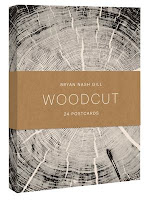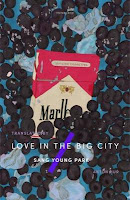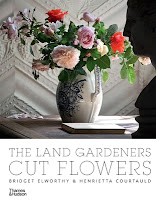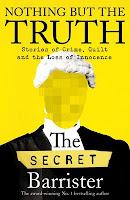Unfortunately, our Book of the Week is urgently relevant in many parts of the world at the moment, and increasingly relevant elsewhere. Timothy Snyder's ON TYRANNY: Twenty lessons from the Twentieth Century alerts us to the tell-tale signs of a society shifting away from democracy and towards authoritarianism, and gives us some simple but effective ideas on combatting this. This graphic edition of this important book is given even greater depth and resonance by the illustrations by Nora Krug. Beware!
>>How the illustrations were made.
>>"If we don't observe carefully we don't know how to intervene."
>>The dangers of passive allegiance.
>>Some pages.
>>"It turns out that people really like democracy."
>>Other excellent books by Timothy Snyder.
>>Also by Nora Krug.
>>Your copy of On Tyranny.
| >> Read all Stella's reviews. | |
Metronome by Tom Watson {Reviewed by STELLA} It’s the near future and a couple are near the end of a twelve-year exile. The Warden is due to uplift them from their remote island prison where they have lived a subsistence existence reliant on yearly supply drops, what they scavenge from shipwrecks, and pills deposited at eight-hour intervals. The yearly supply drops have become non-existent. The Warden hasn’t shown up the last three years. Whitney sees this as a test — of their loyalty to the regime and their contrition. Aina is more doubtful — increasingly suspicious of not only the Warden and the regime but also her husband. 'No one is coming' is the refrain that ebbs at the edges of her mind. The shipwrecks, which had become more frequent, have dwindled as they see fewer signs of any human behaviour. Yet when a yacht is pitched up on the Needles — a sharp range of rocks just off the coast — it is surprisingly rich with treasures and unsettlingly obvious that human inhabitants have been living on board recently. But where are they? Whitney is sure they have come on land. Aina is more puzzled by their lack of access to pills. How could they survive without them? And that brings us to the Pill Clock. Every eight hours, via identification by thumbprint technology, a pill is dispensed — one for Whitney and one for Aina. Without the medication, they will die, poisoned by the atmosphere. This is a climate hell — low on resources, crappy weather (a massive flood triggers chaos as well as a personal catastrophe), and bad air. The pill dispenser keeps them tethered to the croft and the patch on land they live on. They are controlled, even at a distance, by the schedule of the clock — by the prison sentence. As the day of their freedom comes and passes, the couple respond in opposing manners. Whitney’s concept of 'the test' is reinforced, while Aina is determined to unpick the doubts she harbours and the questions that bother her about the island. Is it really an island? If yes, where did the lone sheep come from and why is Whitney determined to keep her from exploring beyond a craggy range? This schism, in conjunction with an unexpected encounter, undermines their relationship and pulls them both back to an unbearable past. A past where breaking the rules — having a child without permission — resulted in their banishment, and Maxime, their son, taken by the state. It was an oppressive regime, where citizens toed the line, dobbing in others, hoping to remain unnoticed or to be socially rewarded. Yet saving your own skin in this conservative regime didn’t, you realise as the story unfolds, keep the wolf from the door — resources became scarce and the environment harsher. Whitney and Aina, completely isolated, know little, and as Aina makes a decision to leave, determined to find Maxime, it is unclear whether this will be her redemption or destruction. Tom Watson’s debut focuses on the tense relationship between the couple, their diverging perspectives, lack of trust in each other, and disintegrating grip on reality. Metronome is tightly drawn with the clockwork precision and logic of survival, balancing the emotional turmoil of love and betrayal in this remote atmospheric landscape. |
| >> Read all Thomas's reviews. | |
|
NEW RELEASES
Winter Time by Laurence Fearnley $36Having returned to the Mackenzie Country to deal with the unexpected death of his brother, Roland has more than enough on his plate. The last thing he needs are the demands of a cantankerous neighbour, the complaints of his partner back in Australia and to find that someone is impersonating him on Facebook, stirring up the locals against him. Even the weather is hostile, rendering roads unpassable, his old home an icebox and the fire offering little comfort. And yet, when cycling on the empty roads, cocooned in a snow-muffled landscape, he finds he can confront what he actually feels.
"Fearnley's prose is precise, spare, springy with cadences of colloquial Kiwispeak, yet resonant with imagery." —David Hill
>>Other books by Laurence Fearnley.Galatea by Madeline Miller $13
>>Hassan introduces the book.
>>Hassan's poetry collection National Anthem was short-listed in the 2021 Ockham New Zealand Book Awards.
>>Kitty's story — and some recipes!
>>A brief sample.
The short lists for the 2022 NEW ZEALAND BOOK AWARDS FOR CHILDREN AND YOUNG ADULTS have just been announced. >>Click through to find out more — and to make your choices.
>>Read what the judges have to say.
Our Book of the Week has just been awarded the 2022 INTERNATIONAL BOOKER PRIZE.
TOMB OF SAND by Geetanjali Shree, translated from the Hindi by Daisy Rockwell, was described by the judges as "a book that is engaging, funny and utterly original, at the same time as being an urgent and timely protest against the destructive impact of borders and boundaries — whether between religions, countries or genders."
>>"All languages have the possibility of crossing borders."
>>Stories imbue your senses.
>>On translating Tomb of Sand.
>>Ballroom dancers.
>>"An exuberance and a life."
>>Showered in language.
>>"The most original and undefinable work of our times."
>>On the author's bookshelf.
>>On the translator's bookshelf.
>>"Writers make national literature; translators make universal literature."
>>Fun shorts.
| >> Read all Stella's reviews. | |
The Secrets of Cricket Karlsson by Kristina Sigunsdotter, illustrated by Ester Eriksson (translated from Swedish by Julia Marshall) {Reviewed by STELLA} Ever been eleven and lonely? Or wondered why your best friend is hanging out with the mean kids? Or wished your mother didn’t sigh so much? If you answer yes to any of these questions then you need Cricket Karlsson. Ever wanted to make art? Ride a horse in the moonlight? Ever been unable to get out of bed or unable to get someone you love out of bed? Then you need Cricket Karlsson. Cricket Karlson is eleven, has a ‘potato’ heart (which is currently mashed because her best friend Noa isn’t talking to her), is finding out about love, is visiting her aunt in the psych ward, loves to draw and doesn’t like the horse girls. And she has secrets — secrets that only a best friend, like Noa, knows! The Secrets of Cricket Karlsson from the pen of Kristina Sigunsdottir and the brush of Ester Eriksson is another standout from Gecko Press. I loved it, and it’s even better on the second reading. It has lists of not very Ugliest Words, absurd and unlikely Things Grandpa Says you Can Die From, unusual Psychiatric Illnesses I Don’t Want, and delightful Secrets I Have Only Told to Noa. Told with the keen observation of an eleven-year-old with all the concerns of childhood and changing circumstances, the words leap off the page with feistiness, humour and pathos. It lightly touches on worries and fears (climate change, mental health, sadness, regret) while embracing the best things about being that age when you’ll still a kid, but only just. Who hasn’t noticed the horse girls with their neighing and prancing, or squirmed when a boy (or a girl) is doe-eyed and you just don’t like him like that, or locked themselves in the bathroom (sometimes crying) to avoid being harassed? Cricket Karlsson finds out that life isn’t always what you expect, that loneliness passes, and that even an eleven-year-old can make a sad person happy. Black humour abounds and Cricket Karlsson is a star (with secrets and lists, a big heart and a little mischief, and her favourite food is cheese-on-cheese-in-cheese). I think I’ll pop to bed and read it again. |
| >> Read all Thomas's reviews. | |
1] Wishing to write a review of the novel Armand V. by the Norwegian author Dag Solstad, I’ve decided the best way to realise this is not by writing a review of the novel but by allowing it instead to appear in an outpouring of footnotes to a review that will not be or can not be written. The sum of the footnotes, therefore, is my review of the novel Armand V. |
NEW RELEASES
Ruth & Pen by Emilie Pine $37Pine follows her remarkable 2019 essay collection Notes to Self with a novel of equal clarity and perspicacity. Dublin, 7 October 2019.One day, one city, two women- Ruth and Pen. Neither known to the other, but both asking themselves the same questions — how to be with others and how, when the world doesn't seem willing to make space for them, to be with themselves? Ruth's marriage to Aidan is in crisis. Today she needs to make a choice — to stay or not to stay, to take the risk of reaching out, or to pull up the drawbridge. For teenage Pen, today is the day the words will flow, and she will speak her truth to Alice, to ask for what she so desperately wants.
"Full of empathy and good will." —The Irish Times
>>How literature makes reality feel.
>>A living weapon in your hand.
Read our latest NEWSLETTER and find out what we have been reading and recommending.
>>Read Stella's review.
>>Read Thomas's reviews of The Cage and High Wire.
>>....and then there were none.
| >> Read all Stella's reviews. | |
The Fish by Lloyd Jones {Reviewed by STELLA} Lloyd Jones's latest novel, firmly set in 1960s New Zealand, turns the tables on our expectations. The Fish is a story of a writer, and a tale of a family fraught with shame, tragedy and love. When the teenage daughter, always referred to as The Fish’s Mother, gives birth to ‘Fish’ she is simultaneously both protected and rejected by her family, and by extension, her child also. That this baby is viewed as different — he has googly eyes, a lopsided wide gob, smells strongly and sometimes has gills — is more a reflection of the family’s shame or discomfort with the situation they find themselves in rather than the child in and of itself. Although you do, through the eyes of his uncle (the narrator of this story), get the district impression of an oddity — Fish is not like other children and possibly not like other humans. This otherness lies at the heart of the novel (what happens when you take a fish out of water, or, as a writer, you are both inside and outside of lived family experience?), and the family’s complex responses to Fish, and interactions with each other. Both daughters are wayward: Clara, the eldest, escapes to Sydney, where she works in ‘modelling’ or as she later puts it, the "professional girl-friending" business. The Fish’s Mother is promiscuous and drug-addicted, often found on the ships. Uncle, our narrator, is the youngest of this trio of siblings and, only nine when Clara leaves home and The Fish arrives on the scene, is both witness and victim of the complex family narrative. Anyone who has grown up in a family with a challenging sibling will instantly recognise the conflicting emotions that arise in such family dynamics, moving in a forever-cycle of guilt, blame and shame as well as love and care. Jones hints at incest, but this is ambiguous. Mrs Montgomery’s insistence at naming Fish ‘Colin Montgomery’ after her husband may be her finger-pointing, and her shoplifting, drinking and later dementia may indicate her various forms of escape from the unhappy household. Water — the sea specifically — plays a major character role. As a gentle loving embrace — the house and the caravan (a central refuge, as well as a symbol of heartache, for all the family members at different times in their lives) on the coast, the summers at the beach, the freedom of the ocean, and Fish’s great ability to stay underwater for significant periods of time. And in comparison an angry force, unforgiving and prepared to wreak havoc — the sea (or the ships) take the Fish’s Mother away, washes through Colin Montgomery senior as his heart fails, and a storm, specifically the one that sank the Wahine, swallows its victims — some are spat out, but others are taken to its depths. Lloyd Jones writes with both careful silences — much is unsaid or only hinted at — and descriptive clarity — the Wahine storm is vivid, while the building tempo of 1960s society, piece by piece, reaches a crescendo, its own storm wave. Littered with oblique references to mythology, sea lore, and with metaphoric resonance, The Fish is a thought-provoking novel unafraid, like its protagonist, to travel against the tide while still adhering to what makes a tale compassionate — humanity in all its glory and squall. |
| >> Read all Thomas's reviews. | |
The Very Last Interview by David Shields {"Reviewed" by THOMAS} So, what makes you want to write a review of David Shields’s new book, The Very Last Interview? Then why are you writing one? Every week? Whose idea was that? Surely at your age, you shouldn’t be so bound by obligation or by expectation, or whatever you call it? Yes, but do you really care what these readers might think, and do you even believe that there are such people? Aren’t you being altogether a bit precious? Do you really think that this helps to pay the mortgage, I mean that this makes a direct and measurable contribution towards paying your mortgage? Or even an indirect and unmeasurable but still valuable contribution towards paying your mortgage? Well, what else would you be doing? Surely you’re joking? Okay, we’ve got a bit off the track there. I will reframe my first question. What makes you think that you are able to write a review of David Shields’s new book? Don’t you think your humility is a bit mannered? The Very Last Interview is a book consisting entirely of questions that interviewers have asked David Shields over the years, omitting his answers, assuming he will have answered probably at least most of the questions, and your review, if we can call it that, of this book also consists of a series of questions ostensibly directed at you but without your answers, if indeed there were answers, which is less certain in your case than in the case of David Shields. Is this, on your part, a deliberate choice of approach, and, if so, is it justifiable? Do you really believe that a review written in imitation of, or in the style of, the work under review inherently reveals something about that work, even if the review is badly written, or should your approach rather be attributed to laziness, stylistic insecurity, or creative bankruptcy? Has it ever occurred to you that the supposedly more enjoyable qualities of your writing are actually nothing more than literary tics or affectations, and, furthermore, that it might be these very literary tics and affectations that prevent you from writing anything of real literary worth? Do you think that, by removing his input into the original interviews but retaining the questions, David Shields is attempting to remove himself from his own existence, or merely to show that our identities are always imposed from outside us rather than from inside, or that we exist as persons only to the extent that we are seen by others? Is this, in fact, all the same thing? What do you mean by that statement, ‘We are defined by the limits we present to the observations of others’? What do you mean by that statement ‘There is no such thing as writing, only editing,’ and how does that relate to Shields’s work? Do you think that David Shields, in this book as in the much-discussed 2010 Reality Hunger, sees the individual as an illusion, a miserable fragment of what is actually a ‘hive mind’ or collective consciousness, and that ‘creativity’, so to call it, is another illusion predicated on this illusion of individuality? You don’t? What do you think David Shields would have answered, when asked, as he was, seemingly in this book, “But what is the role of the imagination in this ‘post-literature literature’ that you envision?” and how might this differ from the answer you might give if asked the same question? Shields was asked if he had written anything that couldn’t be interpreted as ‘crypto-autobiography’, but don’t you think the salient question is whether it is even possible to write anything that couldn’t be interpreted as crypto-autobiography? Is a perfectly delineated absence, such as David Shields approximates in The Very Last Interview, in fact the most perfect portrait of a person, even the best possible definition of a person, as far as this is possible at all? But do you actually have a personal opinion on this? Do you think then that you, like Shields, like us all perhaps, are, in essence, a ghost? |
NEW RELEASES
Otherlands: A world in the making by Thomas Halliday $54
An exhilarating journey into deep time, showing us the Earth as it used to exist, and the worlds that were here before ours. Travelling back in time to the dawn of complex life, and across all seven continents, Halliday gives us a mesmerizing up close encounter with eras that are normally unimaginably distant. Halliday immerses us in a series of ancient landscapes, from the mammoth steppe in Ice Age Alaska to the lush rainforests of Eocene Antarctica, with its colonies of giant penguins, to Ediacaran Australia, where the moon is far brighter than ours today. We visit the birthplace of humanity; we hear the crashing of the highest waterfall the Earth has ever known; and we watch as life emerges again after the asteroid hits, and the age of the mammal dawns. These lost worlds seem fantastical and yet every description—whether the colour of a beetle's shell, the rhythm of pterosaurs in flight or the lingering smell of sulphur in the air—is grounded in the fossil record. Otherlands is an imaginative feat: an emotional narrative that underscores the tenacity of life—yet also the fragility of seemingly permanent ecosystems, including our own. To read it is to see the last 500 million years not as an endless expanse of unfathomable time, but as a series of worlds, simultaneously fabulous and familiar.
Wivenhoe by Samuel Fisher $40
A young man is found brutally murdered in the middle of the snowed-in village of Wivenhoe. Over his body stands another man, axe in hand. The gathered villagers must deal with the consequences of an act that no-one tried to stop. Wivenhoe is a haunting novel set in an alternate present, in a world that is slowly waking up to the fact that it is living through an environmental disaster. Taking place over twenty-four hours and told through the voices of a mother and her adult son, we see how one small community reacts to social breakdown and isolation. Fisher imagines a world, not unlike our own, struck down and on the edge of survival. If society as we know it is lost, what would we strive to save? At what point will we admit complicity in our own destruction?
"Quiet, fable-like menace radiates from every page of Wivenhoe. Elegant and searching, it asks vital questions about what it means to be part of a community — about integrity, belonging, and how darkness can go unchecked when isolation and suspicion sets in — questions that now feel more relevant than ever." —Sophie Mackintosh
"Dazzling." —Guardian
"What binds these writers is their emotional connection to music, and their experience of songs as a portal to memories – whether painful or joyful – and a broader understanding of the world. This Woman’s Work is a collection of music writing, but in the loosest possible sense. Here, music is the soil in which all manner of stories take seed and bloom." —Guardian
PLAY THE GAME
Some of the games we have in stock. Just click on the images to find out more, and to make your choices.


Read our latest NEWSLETTER for book news and new books, and to find out what we've been reading and recommending.
The delightfully destabilising Happy Stories, Mostly by Norman Erikson Pasaribu (translated from the Indonesian by Tiffany Tsao) was awarded the Republic of Consciousness Prize (for books published by small presses). >>The other short-listed books for the RoC Prize are also all outstandingly good.
The Netanyahus by Joshua Cohen received the Pulitzer Prize for Fiction for its playful-yet-deeply-serious exploration of the contradictions, currents and undercurrents experienced in American Jewishness.
No-One Is Talking About This by Patricia Lockwood was awarded the Dylan Thomas Prize ("for the best literary work written in English by an author under forty") for her funny and tragic novel of the internet's relationship with what we call 'real life'. >>"The voice of a generation." >>Read Thomas's review.

Tomb of Sand by Geetanjali Shree (translated by Daisy Rockwell)
Cursed Bunny by Bora Chung (translated by Anton Hur)
The Books of Jacob by Olga Tokarczuk (translated by Jennifer Croft)
Elena Knows by Claudia Piñeiro (translated by Frances Riddle)
Heaven by Mieko Kawakami (translated by Sam Bett and David Boyd)
A New Name (Septology VI—VII) by Jon Fosse (translated by Damion Searls)
>>Order your copies now. >>Find out more about the books, the authors, and the translators.
| >> Read all Stella's reviews. | |
Sea of Tranquility by Emily St.John Mandel {Reviewed by STELLA} Emily St John Mandel’s Sea of Tranquility is a book to be lost in. It’s a book about time, living and loving. Superbly constructed, it stretches from 1912 to 2401; from the wildness of Vancouver to a moon colony of the future. A remittance man, Edwin St.John St.Andrew, is sent abroad. He’s completely at sea in this new world — he has no appetite for work nor connection — and makes a haphazard journey to a remote settlement on a whim. Here, he has an odd experience which leaves him shaken. He will return to England only to find himself derailed in the trenches of the First World War and later struck down by the flu pandemic. It’s 2020 and Mirella (some readers will remember her from The Glass Hotel) is searching for her friend Vincent (who has disappeared). She attends a concert by Vincent’s brother Paul and afterwards waits for him to appear, along with two music fans at the backstage door. It’s here, on the eve of our current pandemic, that she discovers that Vincent has drowned at sea. Yet it is an art video that Vincent had recorded and been used in Paul’s performance which is at the centre of the conversation for one of the music fans. The film is odd — recounting an unworldly experience in the Vancouver forest. A short clip — erratic and strangely out of place, out of time. It’s 2203 and Olive Llewellyn, author, is on a book tour of Earth. She lives on Moon Colony Two and is feeling bereft — missing her husband and daughter. It’s a gruelling schedule of talks, interviews and same-same hotel rooms; and, if this wasn’t enough, there’s a new virus on the loose. Her bestselling book, Marienbad is about a pandemic. Within its pages is a description of a strange occurrence which takes place in a railway station. When an interviewer questions her about this passage, she’s happy to talk about it, as long it is off the record. It’s 2401, and detective Gaspery-Jacques Roberts from the Night City has been hired to investigate an anomaly in time. Drawing on his experiences and the book, Marienbad, and finding connections between the aforementioned times and people, will lead him to a place where he will make a decision that may have disruptive consequences. A decision which will cause upheaval. Emily St.John Mandel is deft in her writing, keeping the threads of time and the story moving across and around themselves without losing the reader, and making the knots — the connections — at just the right time to engage and delight intellect and curiosity. Moving through time and into the future makes this novel an unlikely contender to be a book of our time, but in so many ways it is. Clever, fascinating, reflective and unsettling, it’s a tender shout-out to humanity. |




























































































